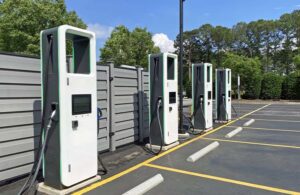Ensuring the safety of electric charging stations in the city, Mumbai Fire Brigade has been drafting a new policy for fire safety purposes at the electric vehicle (EV) charging stations.
 It is also working on setting guidelines for parking e-vehicles across the city, that is likely to be finalized within the next few days, said a senior fire official.
It is also working on setting guidelines for parking e-vehicles across the city, that is likely to be finalized within the next few days, said a senior fire official.
The new policy and guidelines will apply to EV charging stations in all residential and commercial buildings, public parking lots, hospitals, hotels, malls, and petrol pumps in Mumbai. The move came amidst a rapid increase in the use of EVs in the city, especially after the Maharashtra government’s 2021 e-vehicle policy.
Hemant Parab, Chief Fire Officer of Mumbai Fire Brigade, said, “Our primary aim is to prevent electric fire incidents, which is not always in control. The next objective is to ensure the safety of life and property.”
The draft policy is likely to cover categories of safety at e-vehicle charging stations in public spaces such as municipal parking lots, semi-public spaces — malls and hospitals, and private spaces — residential buildings, among others. According to Parab, the fire brigade is exploring recommendations such as EV charging stations at parking areas in buildings that could be restricted to top basements with ramp access as this will help them in “pulling vehicles out of the building after fire incidents are under control”. The recommendations in the new policy and guidelines may also include regular fire safety audits of EV charging stations, maintaining well-ventilated parking areas that have charging stations, not storing flammable material and items near such spots, maintaining riser systems, and using fire retardant paints in surroundings. Private buildings with parked EVs are always recommended to have a parking area in the open, instead of an enclosed space, a fire brigade official said.
EV fire incidents are concerning as they continue for a longer period, said Parab, adding, “The structural stability of buildings is affected adversely where burning e-vehicles are parked at or are being charged as these fires burn for a longer period. This could lead to severe accidents, even in the long run, which may not be restricted to the burning e-vehicles.”
Dousing fires caused due to high-power electric batteries in EVs require about three times more water in comparison to other fire incidents. “Such fire incidents also have the highest probability of reigniting within a few hours after they are doused,” Parab said.
Fire mishaps in EVs usually originate from the battery of the vehicles, said a senior official from the Mumbai Fire Brigade. “The causes can include overcharging of an EV, which could lead to overheating of the battery, and eventually cause it to ignite or explode. Apart from this, if EV charging stations are set up on an existing e-network, it can overburden the system and lead to short circuits,” said the official.
The Mumbai fire brigade has also been exploring advanced methods to tackle e-fires, said another senior fire official, adding, “Our tool at present is water, and we can provide as much as it is required. But internationally, it is recommended to use encapsulated fire extinguishing agents, which help douse fires faster.”
